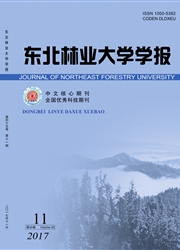

 中文摘要:
中文摘要:
采用面积为1 hm2(100 m×100 m)的大样地来获取黄龙山林区天然油松针阔混交林的树种、树高和直径等测树因子以及每个树种的坐标,利用混交度、大小比数、角尺度3个指标分析了黄龙山林区天然油松针阔混交林公顷级样地的空间结构特征。结果表明:(1)林分乔木层共包括17个树种,物种丰富度较高。油松、辽东栎和白桦的密度和断面积累积量占有明显优势,是乔木层的优势种。(2)林分密度大,直径在4-44 cm均有分布,但4-10 cm的林木较多。(3)整个林分混交度较高,林木多为中度、强度和极强度混交。优势树种油松、辽东栎和白桦的平均混交度分别为0.480、0.711和0.702。(4)在空间结构单元中,林分中林木的各个大小比数分布均匀,林木较稳定,大部分树种是劣态木和绝对劣态木。(5)黄龙山林区天然油松针阔混交林属于团状分布,整个林分的平均角尺度为0.543。
 英文摘要:
英文摘要:
We determined stand parameters including the tree height, diameter, basal area, and the coordinate of each tree in a 1-hm2 plot ( 100 mx 100 m), and described the spatial structural characteristics of plot-level stand of Pinus tabulaeformi mixed forest in Huanglong Mountain using mingling degree, neighborhood comparison and uniform angle index. There were 17 species in arbor layer with comparatively higher species richness. Among all the species, Pinus tabulaeformi, Quercus liaotanggensis and Betula platyphylla made up three dominant species for their population density and basal area had the obvious advantage. The stand density was high, and the DBH ranged from 4 to 44 cm with the majority extent from 4 to 10 cm. The mingling degree of whole stand was high and most of the woods were moderate, strong and extreme mixed. The mingling degree of Pinus tabulaeformi, Quercus liaotanggensis and Betula platyphylla were 0.51, 0.71 and 0.69, respectively. In the spatial structure unit, the number of neighborhood comparison evenly distributed, so the forest was stable. Most woods are in bad state and absolute poor state. The uniform angle index of the whole stand was 0.545, and the Pinus tabulaeformi mixed forest of Huanglong Mountain was aggregative distribution.
 同期刊论文项目
同期刊论文项目
 同项目期刊论文
同项目期刊论文
 期刊信息
期刊信息
